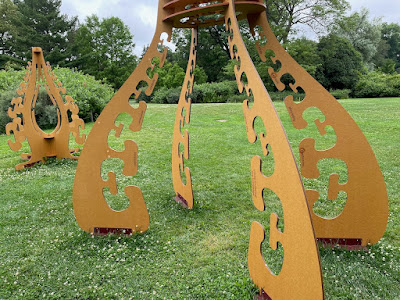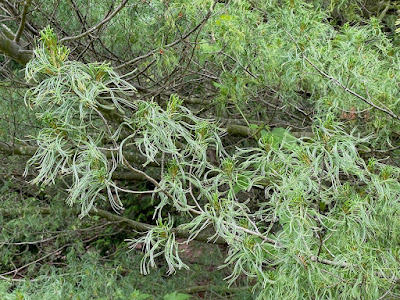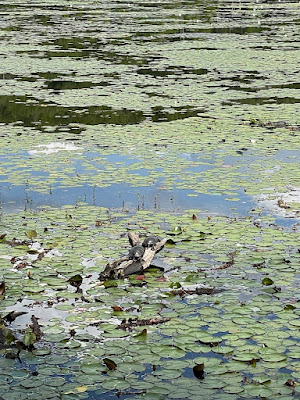Thursday, June 29, 2023
Freed from the demands of realism
Wednesday, June 28, 2023
Tuesday, June 27, 2023
Trees as community hosts
 Natsuki Takauji explains her "The Heart of the Tree": personification of nature is fundamental in Japanese mythology and Shintoism; I grew up interpreting trees as spirits, gods, shelter, or even myself, a human. The piece was watched over by a bird, which hopped around to keep an eye on me as I circled it.
Natsuki Takauji explains her "The Heart of the Tree": personification of nature is fundamental in Japanese mythology and Shintoism; I grew up interpreting trees as spirits, gods, shelter, or even myself, a human. The piece was watched over by a bird, which hopped around to keep an eye on me as I circled it.Monday, June 26, 2023
Religious Anthropocene
Sunday, June 25, 2023
Witness
 Fifth Avenue, offering trays of water to people marching by as well as garbage bags for them to dispose of the empty plastic cups. Between groups, I pondered the folks gathered to watch the parade, and considered how much has changed since 2000 - and how precarious some of its victories feel today. What a blessing to be reminded how many of us there are, from every station of life, and how various.
Fifth Avenue, offering trays of water to people marching by as well as garbage bags for them to dispose of the empty plastic cups. Between groups, I pondered the folks gathered to watch the parade, and considered how much has changed since 2000 - and how precarious some of its victories feel today. What a blessing to be reminded how many of us there are, from every station of life, and how various.
Friday, June 23, 2023
Background trees
 It's not that I didn't find works to like, such as "Landscape from Saint-Rémy" (June 1889), from the section of the exhibition where cypresses are not the main concern. (This was included also because its landscape is a precursor to the painting at the center of this show.)
It's not that I didn't find works to like, such as "Landscape from Saint-Rémy" (June 1889), from the section of the exhibition where cypresses are not the main concern. (This was included also because its landscape is a precursor to the painting at the center of this show.)
Abandon hope - or don't
 Our congregation usually has two "summer reads" each year. I'm never there for the discussions, and won't be this year either, but I decided it wouldn't hurt to have a look at this July's read, Brian McLaren's Do I Stay Christian? A Guide for the Doubters, the Disappointed, and the Disillusioned. The book assembles many reasons why people might want to distance themselves from Christianity (all the folks he mentions are burned-out pastors, mostly Evangelical), then offers some reasons one might choose nevertheless to stay.
Our congregation usually has two "summer reads" each year. I'm never there for the discussions, and won't be this year either, but I decided it wouldn't hurt to have a look at this July's read, Brian McLaren's Do I Stay Christian? A Guide for the Doubters, the Disappointed, and the Disillusioned. The book assembles many reasons why people might want to distance themselves from Christianity (all the folks he mentions are burned-out pastors, mostly Evangelical), then offers some reasons one might choose nevertheless to stay.
The book's final section, coming after the insistence that he respects whatever choice people make, proposes ways of living more humanly either way, beyond the sins of the church. The reasons for leaving were familiar to me, surrounded as I am by religious nones: Anti-Semitism, Christian vs. Christian violence, Crusader colonialism, institutionalism, money, white patriarchy, toxic theology, lack of transformation, constricted intellectualism, demographics.
Those for staying were newer. Here are the names of the chapters:
11 Because Leaving Hurts Allies (and Hurts Their Opponents)
12 Because Leaving Defiantly or Staying Compliantly Are Not My Only Options
13 Because ... Where Else Would I Go?
14 Because It Would Be a Shame to Leave a Religion in Its Infancy
15 Because of Our Legendary Founder
16 Because Innocence Is an Addiction, and Solidarity Is the Cure
17 Because I'm Human
18 Because Chistianity Is Changing (for the Worse and for the Better)
19 To Free God
20 Because of Fermi's Paradox and the Great Filter
I confess I skimmed rather than read these, most of which seem like variations on the same few themes. But a few surprised and intrigued me. 16 built on McLaren's experiences of the curdling sanctimony of the pro-life movement to diagnose a quest for innocence which is really about finding and demonizing others, fancying yourself their innocent victim while relishing the thought that they'll roast in hell. There's nothing innocent about this desire, he says, but this "cult of innocence" is among the main reasons many people become and stay Christian. Hateful hypocrites! McLaren confesses
one of the prime reasons I sometimes want to leave Christianity is to achieve innocence.Tuesday, June 20, 2023
Urban orchard
Saturday, June 17, 2023
Thursday, June 15, 2023
Tree care
 ensure the cut branch falls in a safe place, good and bad kinds of tree beds, consequences of more and less effective past prunings, the endless movements of cars and trucks - but it was also fun. As promised, passers-by stopped to enquire and admire, and some volunteered information about the travails of their own street trees.
ensure the cut branch falls in a safe place, good and bad kinds of tree beds, consequences of more and less effective past prunings, the endless movements of cars and trucks - but it was also fun. As promised, passers-by stopped to enquire and admire, and some volunteered information about the travails of their own street trees.Wednesday, June 14, 2023
Needle point
Tuesday, June 13, 2023
Citizen arborists
 Have I mentioned that I scored a spot in the coveted Trees New York Citizen Pruners class? (All slots in this season's four concurrent sessions were snapped up within fifteen minutes.) The third of three zoom sessions is tonight, to be capped with an in-person pruning experience on Thursday, and I can feel my relationship with street trees changing.
Have I mentioned that I scored a spot in the coveted Trees New York Citizen Pruners class? (All slots in this season's four concurrent sessions were snapped up within fifteen minutes.) The third of three zoom sessions is tonight, to be capped with an in-person pruning experience on Thursday, and I can feel my relationship with street trees changing.
For one, I've finally had to learn some tree identification. Our final exam will ask us to identify five from the city's sixteen most common street trees. It really does make a difference to know and recognize them! Then add things we've learned about how street trees are selected and cared for (nothing's left to chance) and appreciate the diversity of trees and tree combinations on each street.
So I've been walking the streets with interactive NY Tree Map (which I've known about for years) on my phone and I'm getting better and better - though I still waver between pinnately compound leaves of thornless honeylocust (a grafted cultivar) and Japanese pagoda tree, the finely toothed and uneven leaves of elm and linden.
 The map offers details about 875,480 street trees and has recently been supplemented with details of trees in many parks. Each tree is recorded with species, girth, location and forester's visits and tree-care activities. (The site also gives speciously precise values for each tree's "Ecological benefits": stormwater intercepted, energy conserved, air pollutants removed. The willow oak outside school, for instance, apparently saves $321.42 each year. A little silly, but I guess I appreciate the idea.)
The map offers details about 875,480 street trees and has recently been supplemented with details of trees in many parks. Each tree is recorded with species, girth, location and forester's visits and tree-care activities. (The site also gives speciously precise values for each tree's "Ecological benefits": stormwater intercepted, energy conserved, air pollutants removed. The willow oak outside school, for instance, apparently saves $321.42 each year. A little silly, but I guess I appreciate the idea.)
The tree map is the impressive work of citizen volunteers but could use some work. After many a delighted discovery, including happening on newly planted trees not yet registered, I was caught short by glitches on streets I walk every day. (The south side of West 12th between Seventh and Sixth, for instance, ends with two littleleaf lindens and two ginkgos, but the map has flipped them.)
But for now it's a pleasure to be part of a community of people who think and care explicitly about street trees - some of the hardiest and hardest-working of trees, living in sometimes appallingly inhospitable circumstances - and who can feel a comfortingly natural counterpoint to city life precisely because they are so thoughtfully worked by collaborating human hands.Saturday, June 10, 2023
Friday, June 09, 2023
Release
Thursday, June 08, 2023
Perfect storm
 Oh, my. Yesterday was really really bad! The article has a cool time-lapse map. Still, it was brief, and it seems to be blowing over.
Oh, my. Yesterday was really really bad! The article has a cool time-lapse map. Still, it was brief, and it seems to be blowing over.














































